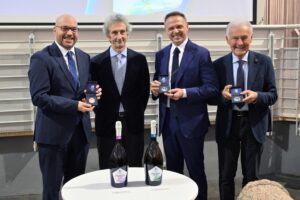
If wine culture has grown significantly in recent decades, the same can’t be said about the understanding of how the shape of a wine glass affects sensory perception. This is why “astonishment and disbelief” still accompany comparative tastings of the same wine in different glasses, especially when notable differences emerge between sips. Even within the technical world, among producers, oenologists, and sommeliers, attention to the type of glass used to enhance different wines, although much improved, still struggles to gain widespread acceptance. More time and comparative experiences are needed, such as the one proposed by Italesse during the presentation of Amarone della Valpolicella glass. This glass is the result of the Senses Project and experimentation by the T-made Lab team of enologists, sommeliers, and technicians, with the support of the Historic Families - Allegrini, Begali, Bertani, Brigaldara, Guerrieri Rizzardi, Masi, Musella, Speri, Tedeschi, Tenuta Sant’Antonio, Tommasi, Torre D’Orti, and Zenato - not only in providing wines for testing but also in discussing which characteristics to highlight or moderate during the tasting of this great Veronese red made from dried grapes. This close collaboration with producers adds significant value to Italesse project, which already offers a new way of looking at wine expression through the glass.
Until now, the “world of wine glasses” - aside from materials and craftsmanship - has been differentiated mainly by wine type, using a simple approach dedicating “universal” glasses for white, red, and sparkling wines, or models designed for specific grape varieties. While this is a good approximation, considering the significant influence of the glass’s shape on organoleptic perception - it is hard to imagine, for example, that both a Burgundian and an Australian Chardonnay could reach their full expression in a glass of the same shape, as terroir plays a decisive role. The intrusion, so to speak, of terroir into wine enhancement led Italesse to develop the “sensory glass” dedicated to wines like Brunello di Montalcino, the official glass of its Consortium, Barolo, and - completing the trilogy of excellent reds - Amarone, with the T-made 76 AV (the number refers to the total capacity in centiliters), officially presented to the media and professionals at the Antica Bottega del Vino in Verona, a true temple of wine. In the same ultra-professional T-made collection, in the “Leggerissimi” version, mouth-blown and handcrafted, there are also glasses designed for Vermentino wines from Sardinia and Gallura, and the official glass of Ribolla di Oslavia Producers Association for their orange wines.
“Working on Amarone was an extraordinary challenge for us - said Massimo Barducci, Ceo Italesse - which required 24 months of design and testing, 690 tastings, and the creation of six different prototypes to identify the final shapes of this glass, which respects Amarone’s structure and complexity while also conveying its aromatic finesse, offering the lightness and elegance that define the T-made collection”. A true challenge, just like the one Amarone itself is facing - with its high alcohol content - it must now mitigate the effects of climate change, which is increasing alcohol levels and accelerating grape drying both of which can compromise sensory richness. The search for the optimal glass shape focused on enhancing complexity and tannic texture while moderating the perception of alcohol. The final design features a wide, flat base to soften the alcohol’s impact and highlight the wine’s softness and complexity through a large surface-to-oxygen ratio, a rim diameter calculated to enhance olfactory intensity, and a bowl with a sharp edge to accentuate freshness on the palate.
“Amarone represents a unique heritage in the global wine scene - underlined Paolo Lauria, sommelier and Head of Marketing at Italesse - not only for its history and production process, but also for the extraordinary variety of interpretative styles that this glass is able to convey. There is a need for greater awareness around glass culture and stronger collaboration with fine dining establishments to promote the more appropriate use of specific glass shapes, perhaps even imagining a geolocation-based approach aligned with the wine list of a given territory. Choosing the right glass is also a tool to avoid compromising food pairings, or even to correct them when a guest, based on personal taste, selects a wine that may not be ideal for the dish, which might require, for example, more freshness or a more pronounced tannin”. Of course, this may sound like science fiction for now, especially when even proper serving temperature is still rarely practiced, but it’s important to aim beyond current limitations.
Italesse, a leading company in Italy, has adopted an aggressive pricing strategy with the goal of strengthening its international presence. “The success of the Senses Project, thanks to the creation of an internal lab - underlined Barducci in conclusion - encourages us to look beyond national borders, toward great international wines such as Bordeaux and Burgundy, with the ambition of offering glasses which can enhance each wine identity with tailor-made precision”. However, the international expansion of Muggia (Trieste) company’s glasses began years ago, with the arrival of Massimo Barducci himself, who pushing for internationalization starting from France, he positioned Italesse glasses in prestigious maisons such as Veuve Clicquot and Laurent-Perrier, but, so to speak, “undercover”, i.e. with the name of their brands.
Copyright © 2000/2025
Contatti: info@winenews.it
Seguici anche su Twitter: @WineNewsIt
Seguici anche su Facebook: @winenewsit
Questo articolo è tratto dall'archivio di WineNews - Tutti i diritti riservati - Copyright © 2000/2025